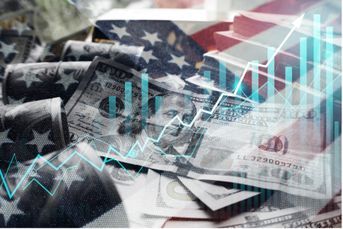Fed raises interest rates; signals 2 more hikes this year for total of 4
Falling unemployment and rising inflation put pressure on policymakers.
Federal Reserve officials raised interest rates for the second time this year and upgraded their forecast to four total increases in 2018, as unemployment falls and inflation overshoots their target faster than previously projected.
The so-called “dot plot” released Wednesday showed eight Fed policy makers expected four or more quarter-point rate increases for the full year, compared with seven officials during the previous forecast round in March. The number viewing three or fewer hikes as appropriate fell to seven from eight. The median estimate implied three increases in 2019 to put the rate above the level where officials see policy neither stimulating nor restraining the economy.
The Federal Open Market Committee indicated that even though it’s stepping up the pace of interest-rate hikes, economic growth should continue apace. “The committee expects that further gradual increases in the target range for the federal funds rate will be consistent with sustained expansion of economic activity, strong labor market conditions, and inflation near the committee’s symmetric 2% objective over the medium term,” according to its statement following a meeting in Washington.
The statement omitted previous language saying that the main rate would remain “for some time” below longer-run levels. Other changes included referring to “further gradual increases” instead of “adjustments.” Officials also said that “indicators of longer-term inflation expectations are little changed.” Previously, the statement made separate references to survey-based and market-based measures of such expectations.
The S&P 500 Index of U.S. stocks fell after the Fed decision, while benchmark 10-year yields were up to 2.98% from Tuesday’s 2.96%. The Bloomberg dollar spot index, which tracks the performance of a basket of 10 global currencies against the greenback, climbed 0.1% on the day.
While the course of interest-rate hikes remains gradual, the slightly more aggressive pace shows officials see more urgency to tighten policy, as unemployment already fell in May to the level they had forecast for year-end. U.S. growth is also getting a boost from $1.5 trillion in tax cuts and a $300 billion increase in federal spending, with inflation at the central bank’s 2% target for two months.
The statement retained language in place since late 2015 saying “policy remains accommodative.” Fed officials repeated their assessment that “risks to the economic outlook appear roughly balanced.”http://edit.investmentnews.com/assets/graphics src=”/wp-content/uploads2018/06/CI115945613.PNG”
‘Solid Rate’
“Economic activity has been rising at a solid rate,” the FOMC said in its statement. “Recent data suggest that growth of household spending has picked up, while business fixed investment has continued to grow strongly.”
Wednesday’s decision — the sixth quarter-point increase in 18 months, raising the benchmark federal funds target rate to a range of 1.75% to 2% — was a unanimous 8-0.
Chairman Jerome Powell is scheduled to hold a press conference at 2:30 p.m., his second since taking the helm from Janet Yellen in February. Mr. Powell has repeatedly played down the dot plot as a guide to future interest rates, though investors continue to focus on it.
Updating their quarterly forecasts, officials projected the policy rate at 3.1% at the end of 2019, according to their median estimate — compared with 2.9% seen in March — and 3.4% in 2020, unchanged from the prior forecast.
Officials lowered their jobless-rate estimates after unemployment fell to 3.8% as of May, matching April 2000 as the lowest reading since 1969. U.S. payrolls expanded by more than 1 million workers in the first five months of 2018, reaching the milestone faster than in the previous two years.
Fed policy makers now see U.S. unemployment at 3.6% in the fourth quarter, followed by 3.5% in 2019 and 2020, based on median projections. That compares with March’s forecasts for 3.8% this year and 3.6% in the following two years. Estimates of the long-run sustainable unemployment rate were unchanged at 4.5%.
Inflation Forecasts
On inflation, policy makers forecast a slight overshoot of their target starting in 2018 at 2.1%, and running through 2019 and 2020, compared with a 2020 overshoot in March’s projections. The Fed’s preferred price gauge — the Commerce Department’s personal consumption expenditures index — rose 2% from a year earlier in March and April, after spending most of the past six years below it.
The core PCE index, which excludes food and energy and is seen by officials as a better gauge of underlying price pressures, is forecast to reach 2% this year and 2.1% in 2019 and 2020. The index rose 1.8% in April from a year earlier.
U.S. central bankers again emphasized on Wednesday that the goal is “symmetric,” and they said in minutes of the May meeting that “a temporary period of inflation modestly above 2%” would help anchor long-run inflation expectations around the target.
The median estimate for economic growth this year rose to 2.8% from 2.7% in March, with projections unchanged for 2.4% in 2019 and 2% in 2020. The committee’s forecast for the long-run sustainable growth rate of the economy held at 1.8%, suggesting policy makers are skeptical of the effect of tax cuts on the economy’s capacity for growth.
Learn more about reprints and licensing for this article.








